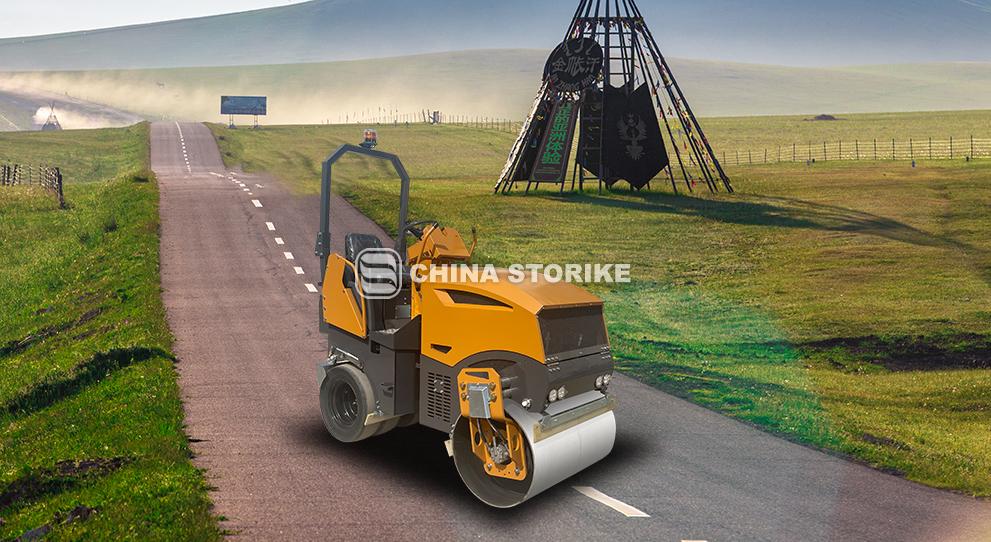(1) The compaction of cement stabilized soil base layer refers to a mixture with a certain compressive strength obtained by mixing, compacting, and curing a certain amount of cement and water into loose broken soil. For the road base paved with cement stabilized soil, the following matters shall be paid attention to when rolling: ① After the mixture is roughly paved on the road section, it shall be quickly rolled once with a tire roller, tractor, and grader, and then leveled. ② After shaping the base layer, use a three wheel smooth roller or heavy-duty tire roller or vibrating roller with a capacity of more than 12t to compact within the basic width. In straight sections, rolling should be carried out from the shoulders on both sides towards the center of the road; In curved sections, rolling should be carried out from the inner shoulder to the outer shoulder. When rolling, the overlapping width should be 1/2 of the width of the rear wheel, and the edges and shoulders of the stable layer should be pressed 2-3 times more. When the water content is greater than 2%, it should be rolled more than 6 times, with a rolling speed of 1.5-1.7km/h for the first two passes and 2-2.5km/h for the following passes. During the rolling process, it is not allowed to "turn around" or emergency brake on the completed or ongoing road section to avoid damaging the surface of the base layer During the rolling process, prevent the occurrence of "springs", looseness, and peeling, and sprinkle a small amount of water when dry In the later stage of rolling, excessive stress or rolling time should be avoided to prevent reducing the strength of cement stabilized soil. Then, during the final compaction, a smooth wheel roller should be used to improve the smoothness of the base surface. ⑤ Use a tire roller for rolling, with a weight of 10-20 tons, a tire pressure of around 0.7 MPa, and a number of wheels between 7 and 11. ⑥ When stable soil is laid on a soft roadbed, a vibration roller with medium to low line pressure is selected. When the compaction density increases, the paving material becomes hard, and the roller experiences slight bouncing, the amplitude should be reduced to avoid damaging the machine components.
(2) The compacted lime stabilized soil base layer refers to a mixture with a certain compressive strength obtained by mixing, compacting, and curing loose crushed soil with an appropriate amount of lime and water. For road base or subbase with lime stabilized soil as auxiliary material, the following precautions should be taken during rolling: ① Before rolling, the water content of the mixture needs to be checked. When the moisture content is 1% -2%, the rolling effect is better. When the moisture content is insufficient, additional watering should be added, and when the moisture content is too high, it should be turned over and sun dried After manual paving and shaping, first use a tractor, 6-8t series roller, or tire roller to compact 1-2 times; Then, use a static smooth wheel roller with a capacity of more than 12t for rolling until the density of the mixture reaches 95% -98%. ③ When using lime stabilized soil as the subbase of advanced pavement, the content of water and lime should be accurate. When rolling, heavy static rollers should not be used multiple times. Instead, vibration rollers should be used. First, the vibration source should be disconnected for static compaction, then the vibration compaction should be gradually carried out, and then the vibration source should be disconnected for static compaction.

(3) Lime stabilized industrial waste base compaction Lime stabilized industrial waste refers to the mixture obtained by mixing a certain amount of lime, fly ash (or coal slag) with other aggregates (or without other aggregates), adding an appropriate amount of water, mixing, compacting, and curing. Due to the significant impact of the compactness of this mixture on its strength, it is advisable to use a heavier roller for compaction. Usually, a medium-sized roller is used for initial compaction 3-4 times, and then a heavy-duty roller is used to continue rolling 6-8 times until the required compactness is achieved.
(4) The compacted graded aggregate of graded aggregate base layer refers to a mixture composed of crushed stone, gravel, or crushed gravel mixed according to particle size. For the base layer paved with this mixture, vibration rollers can be used for compaction, or static smooth wheel rollers with a capacity of more than 12t, heavy-duty tire rollers, or vibration rollers can be used together with tire rollers for compaction.
(5) The compaction of gap filled crushed stone base refers to the road base layer formed by layering and rolling different specifications of large, medium, and small single size crushed stones. This type of base layer should be laid in two steps: first, lay large crushed stones and compact them; Lay small crushed stones again and compact them. The first compaction should be carried out using an 8-10t static tandem roller or a 5t vibrating roller for rapid compaction, and all the filling material should be vibrated into the pores of the coarse gravel. Continue to use a vibrating roller to compact the small gravel after the second paving. After all the pores on the surface of the crushed stone are filled, use a 12-15t static smooth wheel roller to finally press 1-2 times until the surface is flat and stable, without obvious wheel marks or stone creep.
Contact: Ms. Anna
Phone: +8613964983086
E-mail: Alex.cui@storike.com
Add: Incalcu Industrial Park, 327 National Road, High-tech Zone, Jining City, China., Jining, Shandong, China